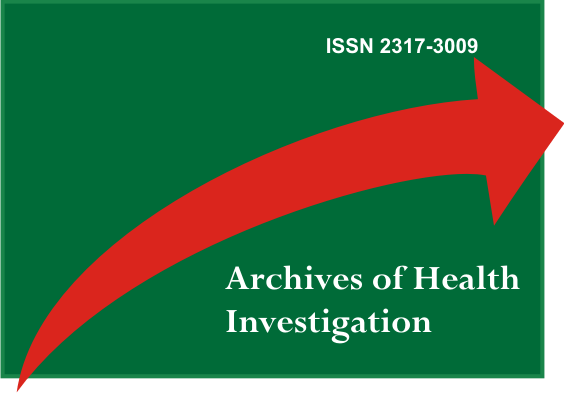Ameloblastoma em maxila: sugestão de abordagem cirúrgica
DOI:
https://doi.org/10.21270/archi.v7i12.3097Resumo
Introdução: O ameloblastoma é um tumor benigno, localmente invasivo, originário do epitélio odontogênico e é a neoplasia odontogênica mais comum. Apresentam crescimento lento e sua ocorrência na maxila é pouco frequente. Objetivo: Discutir os métodos de tratamento para os ameloblastomas em maxila e demonstrar a utilidade da osteotomia Le Fort I na abordagem destas lesões. Material e Método: Estudo descritivo de relato de caso. Resultados: Observou-se a erradicação da lesão com uma abordagem de baixa morbidade e que permitiu bom resultado estético e funcional. Conclusão: A ressecção é o método mais indicado para tratamento dos ameloblastomas sólidos, e a sua realização utilizando a osteotomia Le Fort I podem trazer vantagens tanto no trans quanto no pós-operatório.Descritores: Ameloblastoma; Maxila; Osteotomia de Le Fort.
Referências
- Kreppel M, Zöller J. Ameloblastoma - Clinical, radiological, and therapeutic findings. Oral Dis. 2018;24(1-2):63-6.
- Taylor EM, Wu W, Kamali W, Ferraro P, Upton N, Lin J et al. Medial femoral condyle flap reconstruction of a maxillary defect with a 3D printing template. J Reconstr Microsurg Open. 2017;2:e63-8.
- Menezes LM, Souza CEL, Carneiro JT, Silva Kataoka MS, Júnior SDMA, Pinheiro, JDJV. Maxillary ameloblastoma in an elderly patient: report of a surgical approach. Hum Pathol. 2017;10:25-9.
- Laborde A, Nicot R, Wojcik T, Ferri J, Raoul G. Ameloblastoma of the jaws: Management and recurrence rate. Eur Ann Otorhinolaryngol Head Neck Dis. 2017;134(1):7-11.
- Milman T, Ying GS, Pan W, LiVolsi V. Ameloblastoma: 25 year experience at a single institution. Head Neck Pathol. 2016;10(4):513-20.
- Pogrel MA, Montes DM. Is there a role for enucleation in the management of ameloblastoma? Int J Oral Maxillofac Surg. 2009;38(8):807-12.
- Antonoglou GN, Sándor GK. Recurrence rates of intraosseous ameloblastomas of the jaws: a systematic review of conservative versus aggressive treatment approaches and meta-analysis of non-randomized studies. J Craniomaxillofac Surg. 2015;43(1):149-57.
- Almeida RA, Andrade ES, Barbalho JC, Vajgel A, Vasconcelos BC. Recurrence rate following treatment for primary multicystic ameloblastoma: systematic review and meta-analysis. Int J Oral Maxillofac Surg. 2016;45(3):359-67.
- Rizzitelli A, Smoll N, Chae M, Rozen WM, Hunter-Smith DJ. Incidence and overall survival of malignant ameloblastoma. PLoS One. 2015;10(2):e0117789.
- Nastri AL, Wiesenfeld D, Radden BG, Eveson J, Scully C. Maxillary ameloblastoma: a retrospective study of 13 cases. Br J Oral Maxillofac Surg. 1995;33(1):28-32.
- Guha A, Hart L, Polachova H, Chovanec M, Schalek P. Partial maxillectomy for ameloblastoma of the maxilla with infratemporal fossa involvement: A combined endoscopic endonasal and transoral approach. J Stomatol Oral Maxillofac Surg. 2018;119(3):212-15.
- Quick-Weller J, Koch F, Dinc N, Lescher S, Baumgarten P, Harter P et al. Intracranial ameloblastoma arising from the maxilla: an interdisciplinary surgical approach. J Neurol Surg A Cent Eur Neurosurg. 2017;78(5):582-87.
- Abtahi MA, Zandi A, Razmjoo H, Ghaffari S, Abtahi SM, Jahanbani-Arkadani H et al. Orbital invasion of ameloblastoma: a systematic review apropos of a rare entity. J Curr Ophthalmol. 2018;30(1):23-34.
- Bettoni J, Neiva C, Fanous A, Olivetto M, Demarteleire S, Demarteleire C et al. Brain ameloblastoma: metastasis or local extension report of a case and literature review. J Stomatol Oral Maxillofac Surg. 2018;119(5):436-39.
- Yang R, Liu Z, Peng C, Cao W, Ji T. Maxillary ameloblastoma: factors associated with risk of recurrence. Head Neck. 2017;39(5):996-1000.
- Kamalpathey LCK, Sahoo MGNK, Chattopadhyay CPK, Issar MY. Access Osteotomy in the Maxillofacial Skeleton. Ann Maxillofac Surg. 2017;7(1):98-103.
- Alexander R, Weber WD, Theodos LV, Friedman JS. The treatment of large benign maxillary tumors via Le Fort I downfracture: report of two cases and review of the literature. J Oral Maxillofac Surg. 1992;50(5):515-7.
- Catunda IS, Melo AR, Medeiros Júnior R, Queiroz IV, Neto F, Leão JC. Osteotomia Le Fort I: Aspectos de interesse no tratamento de nasoangiofibroma juvenil. Rev cir traumatol buco-maxilo-fac. 2011;11(4):9-12.
- Symington OG, Caminiti MF. Le Fort 1 down fracture approach for the treatment of a posterior maxillary ameloblastoma. J Can Dent Assoc. 1995;61(12):1048-52.
- Iwaki LC, Tolentino ES, Lustosa RM, Jacomacci WP, Casaroto AR, Leite PC et al. Le Fort I osteotomy for the removal of a rare unicystic ameloblastoma lesion in the maxillary sinus. Gen Dent. 2016;64(3):16-9.
Downloads
Não há dados estatísticos.
Downloads
Publicado
2019-03-20
Como Citar
Suassuna, T. M., Araújo-Júnior, J. L. de, Lyra, T. C., Silva-Neto, J. C. da, Noleto, J. W., & Dias Ribeiro, E. (2019). Ameloblastoma em maxila: sugestão de abordagem cirúrgica. ARCHIVES OF HEALTH INVESTIGATION, 7(12). https://doi.org/10.21270/archi.v7i12.3097
Edição
Seção
Relatos de Caso


